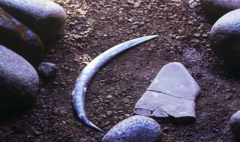The oldest known boomerang, recently dated to approximately 40,000 years old, has reshaped our understanding of early human craftsmanship. Unearthed from the Oblazowa Cave in Poland, this remarkable artifact was once presumed to be 30,000 years old but has now been confirmed to be even older through innovative radiocarbon dating techniques applied to associated human and animal remains.
Crafted from mammoth ivory, this intricate tool demonstrates a significant level of skill, suggesting that early Homo sapiens possessed advanced knowledge of aerodynamics, enabling them to create an object that would travel when thrown, but crucially, would not return. Researchers speculate its primary use was likely for hunting, although it may have also held ritualistic or cultural significance.
Dr. Sahra Talamo from the University of Bologna, who leads the study, emphasized the importance of this finding: “This boomerang offers remarkable insight into human behaviors and ingenuity from 42,000 years ago, showcasing how early peoples were capable of shaping such sophisticated tools for survival.”
The boomerang, which measures about the length of a baseball bat, is well-preserved and features distinctive score marks that indicate it was delicately polished, likely fabricated for use by a right-handed individual. While boomerangs are often linked to Aboriginal cultures in Australia, this discovery highlights a broader historical usage, with various examples from different continents.
Notably, there's a striking contrast with the previously known oldest boomerang from Australia, dated to around 10,500 years ago, emphasizing the potential for early cultures in Europe to have engaged in similar practices long before their Australian counterparts. Archaeological records also document a wooden boomerang from Jutland, found between Denmark and Germany, dating back 7,000 years, illustrating the widespread functionality and significance of this tool.
The comprehensive findings have been detailed in a recent publication in PLOS One, authored by an interdisciplinary team spanning Poland, Italy, Germany, France, Switzerland, and the UK. This research not only alters previously held beliefs about the timeline of boomerang usage but encourages further exploration into the adaptive strategies of early human societies.
Crafted from mammoth ivory, this intricate tool demonstrates a significant level of skill, suggesting that early Homo sapiens possessed advanced knowledge of aerodynamics, enabling them to create an object that would travel when thrown, but crucially, would not return. Researchers speculate its primary use was likely for hunting, although it may have also held ritualistic or cultural significance.
Dr. Sahra Talamo from the University of Bologna, who leads the study, emphasized the importance of this finding: “This boomerang offers remarkable insight into human behaviors and ingenuity from 42,000 years ago, showcasing how early peoples were capable of shaping such sophisticated tools for survival.”
The boomerang, which measures about the length of a baseball bat, is well-preserved and features distinctive score marks that indicate it was delicately polished, likely fabricated for use by a right-handed individual. While boomerangs are often linked to Aboriginal cultures in Australia, this discovery highlights a broader historical usage, with various examples from different continents.
Notably, there's a striking contrast with the previously known oldest boomerang from Australia, dated to around 10,500 years ago, emphasizing the potential for early cultures in Europe to have engaged in similar practices long before their Australian counterparts. Archaeological records also document a wooden boomerang from Jutland, found between Denmark and Germany, dating back 7,000 years, illustrating the widespread functionality and significance of this tool.
The comprehensive findings have been detailed in a recent publication in PLOS One, authored by an interdisciplinary team spanning Poland, Italy, Germany, France, Switzerland, and the UK. This research not only alters previously held beliefs about the timeline of boomerang usage but encourages further exploration into the adaptive strategies of early human societies.


















